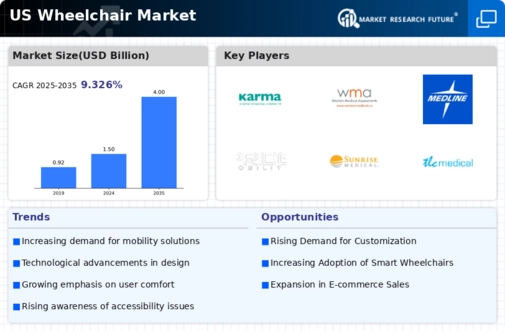Rising Aging Population
The increasing aging population in the US is a pivotal driver for the wheelchair market. As individuals age, mobility issues often arise, leading to a higher demand for mobility aids, including wheelchairs. According to recent statistics, approximately 20% of the US population is projected to be over 65 years by 2030. This demographic shift suggests a growing need for various wheelchair options, including manual and powered models. The wheelchair market is likely to experience substantial growth as healthcare providers and families seek solutions to enhance mobility and independence for older adults. Furthermore, the aging population may also drive innovations in wheelchair design and functionality, catering to the specific needs of seniors, thereby expanding the market further.
Increased Healthcare Expenditure
The rising healthcare expenditure in the US is another significant driver impacting the wheelchair market. With healthcare spending projected to reach $6 trillion by 2027, there is a growing focus on improving patient mobility and quality of life. This trend is likely to result in increased investments in assistive devices, including wheelchairs. Insurance coverage for mobility aids is also expanding, which may lead to higher adoption rates among individuals requiring wheelchairs. The wheelchair market could benefit from this trend as healthcare providers prioritize patient-centered care, emphasizing the importance of mobility solutions in rehabilitation and long-term care. Consequently, the market may see a surge in demand for advanced wheelchair technologies that align with evolving healthcare standards.
Growing Awareness of Disability Rights
The growing awareness of disability rights in the US is a crucial driver for the wheelchair market. Advocacy for equal access and inclusion has led to increased demand for mobility aids that empower individuals with disabilities. Legislative measures, such as the Americans with Disabilities Act (ADA), have reinforced the need for accessible environments, further driving the market. As public awareness of disability issues continues to rise, there is likely to be a corresponding increase in the demand for wheelchairs that meet diverse needs. This trend may encourage manufacturers to develop more versatile and customizable wheelchair options, catering to a broader range of users. Consequently, the wheelchair market could experience growth as society becomes more inclusive and supportive of individuals with disabilities.
Technological Integration in Mobility Solutions
The integration of advanced technologies into mobility solutions is transforming the wheelchair market. Innovations such as smart wheelchairs equipped with sensors, GPS, and connectivity features are becoming increasingly prevalent. These technologies enhance user experience and safety, making wheelchairs more appealing to consumers. The market is witnessing a shift towards electric and automated wheelchairs, which offer greater independence and ease of use. As consumers become more tech-savvy, the demand for these high-tech solutions is likely to rise. Additionally, the wheelchair market may see collaborations between tech companies and manufacturers, leading to the development of innovative products that cater to the needs of users, thereby expanding market opportunities.
Focus on Enhanced User Comfort and Customization
The emphasis on enhanced user comfort and customization is shaping the wheelchair market. Consumers are increasingly seeking wheelchairs that not only provide mobility but also prioritize comfort and individual needs. This trend is prompting manufacturers to invest in ergonomic designs, adjustable features, and personalized options. Research indicates that comfort plays a vital role in user satisfaction and long-term usage of wheelchairs. As a result, the market is likely to see a rise in demand for customizable wheelchairs that cater to specific user preferences and requirements. This focus on comfort and personalization may lead to innovations in materials and design, ultimately enhancing the overall user experience in the wheelchair market.

















Leave a Comment